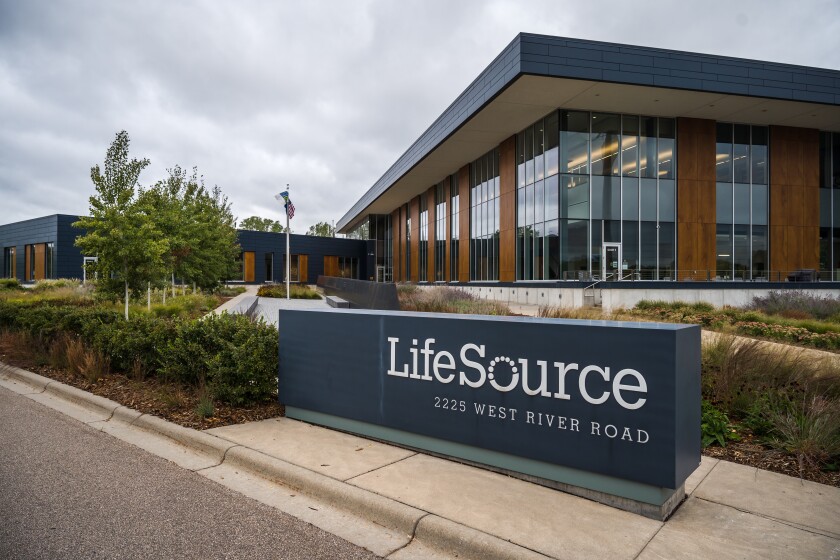ROCHESTER -- In the world of organ transplants, joyous patient milestones are held up as proof of success: the lung recipient who runs a marathon, the kidney transplant patient who pursues medical school, the father whose new heart allows him to walk his daughter down the aisle.
These testimonials serve as examples of what the organ transplant system can accomplish at its best. But behind them lies a business. And even in a business meant to save lives, there are failures, and sometimes money is misused.
ADVERTISEMENT
This issue is at the heart of a congressional investigation into lagging performance and financial mismanagement in organ procurement organizations (OPOs), the critical middlemen who coordinate the transfer of organs from the deceased to those in need.
LifeSource, Minnesota's OPO, is one of the groups under investigation. It was flagged by congressional investigators as being a low performer with potential conflicts of interest.
The brokers of organ transplants have long stayed in the shadows as medical centers have faced regulatory sunlight. The consequences of their poor performance are literally life-and-death.
“OPOs are given blank checks and participation trophies as patients are given death sentences,” said Matthew Wadsworth, CEO of OPO LifeConnection of Ohio, at a federal congressional hearing earlier this year. “It is truly hard to find a more important system with less accountability.”
Congressional leaders and OPO staff are calling out the culture of secrecy that has squashed critical feedback from insiders at places like LifeSource. They're examining how conflicts of interest may abound when procurement organizations work with other lucrative parts of the medical industry.
This is the essence of why investigators say LifeSource was selected: There is concern that the OPO's conflicts may distract from its main mission to recover life-saving organs for the 2,500 Minnesotans ailing on the waitlist.
Taxpayers foot high bills
Organ procurement organizations are perhaps the most obscure players in the transplant system. Yet, their position in the donation pipeline gives them immense power over the nation's supply of organs.
ADVERTISEMENT
“When we boil it down to its very essence, it is a supply-and-demand issue. And (OPOs) sit at the intersection of the supply and the demand. They are controlling it,” said Melissa Blevins Bein, a former OPO official.
Despite this important role, OPOs haven't had an objective marker of their performance until recently.

The government agency that funnels billions of taxpayer dollars into reimbursing OPO costs released a report in late 2019 charging that the system lacked objective metrics, transparency, accountability and incentives for improvement.
That agency, the Centers for Medicare and Medicaid Services, highlighted what insiders have said for decades: OPOs haven’t been able to objectively determine how and where they are failing.
CMS then presented objective metrics by which OPO performance would be measured, regulations that were formally approved earlier this year. Under them, LifeSource has twice been ," a rating that doesn't just translate into financial loss, but potentially lives lost.
ADVERTISEMENT
In tandem, Congress held hearings on OPO oversight that examined lagging performance and financial inefficiencies.
“The entire system is much more expensive to run, largely on taxpayers' dimes, than it should be,” said Greg Segal, co-founder and CEO of the patient advocacy group Organize.
Congressional hearings unearthed alarming examples of financial abuse, including an OPO leader using funds to buy season tickets to national hockey and football games and funding board retreats in Napa Valley. Segal said that not all OPOs intentionally misuse funds, but they often allocate their pots of money inefficiently.
"We're not getting nearly as much value out of the system as patients deserve,” said Segal.
Why is the transplant system so expensive? Take, for example, the costs of dialysis. The U.S. spends upwards of $30 billion annually supporting patients who suffer from kidney failure. That's nearly 1% of the federal budget. If more of those patients — who comprise 84% of the national waiting list — received transplants, the cost would decrease.
On a more granular level, OPOs control how they set costs for their services. Medical centers don't have a lot of power to negotiate these costs, because OPOs are monopolies by nature. They have federally designated service areas, and are the sole provider for that area. Centers can't simply take their business elsewhere if the OPO's costs are too high.
Data provided to the Post Bulletin shows that LifeSource charges much more than its peers.
ADVERTISEMENT
The Minnesota OPO’s average costs ranked as the most expensive in three organ categories — heart, single lung, and pancreas — and acquisition costs ranked in the top 10 most expensive in two other categories.
Retrieving a heart from a deceased donor costs an average of $60,100 at the Minnesota OPO, far above the $44,102 average, according to April 2019 data volunteered by 58 OPOs and provided to the Post Bulletin by a leader in the OPO industry.
A single lung cost $63,800, about $20,000 above the average of $43,912.
Kidney costs for LifeSource sat right above the average at $41,800, though these are the only organs that have a standardized cost structure in the industry.
“Costs relative to organ donation and the transportation of organs vary between DSAs (donation service areas) depending on factors such as geography, population density, surgeon fees, transportation availability, and methodologies for allocating expenses. We cannot discuss comparisons relative to (acquisition costs) in which context is not factored in,” said LifeSource CEO Susan Gunderson. She has led the OPO for 32 years and will retire in 2022.
ADVERTISEMENT
The patient or transplant center isn’t typically the party that pays an OPO. In some cases, private insurance covers the charge. But much of the time, CMS uses taxpayer funds to foot the bill. The transplant center pays the OPO for the initial costs of the transfer. Then, CMS reimburses the center.
Many industry leaders are not surprised that the government agency has finally cracked down on spending.
“CMS wants to be, needs to be, an intelligent consumer of health care services….tax dollars are precious and CMS should be doling out those tax dollars to the places that can deliver them the most good for the money they’ve spent,” said Ginny McBride, executive director of OurLegacy, an OPO in Florida.
“Mismanagement, waste, and abuse”
Organ acquisition costs are just one area under the microscope as part of a deep congressional inquiry into " among OPOs.
LifeSource and 10 other OPOs received a letter from the House Oversight's Subcommittee on Economic and Consumer Policy in December 2020, requesting a flurry of documents, including:
The list of flights used to transplant organs since 2014, passenger logs for each of those flights, and who was billed.
Policies related to disclosing and preventing conflicts of interest.
Financial statements and descriptions of assets and holdings.
Consulting agreements or contracts between OPOs and outside agencies.
Board meeting minutes from the past six years.
Communications with lobbying groups.
The investigation also requested documents listing compensation for board members or officers. LifeSource’s CEO made more than $600,000 in 2019. The top-paid OPO leader in the U.S. made nearly $2 million in 2019 and the lowest made about $140,000. LifeSource, along with at least 30 other OPOs, does not pay board members.
ADVERTISEMENT

LifeSource said it has been “fully compliant” with the investigation, and has provided more than 12,000 documents to the committee. The organization declined to provide any of those documents to the Post Bulletin.
The House Oversight's subcommittee disagrees that LifeSource has been cooperative.
“While LifeSource provided some of the information that the Subcommittee requested, it failed to provide all of the data we requested about its performance,” said a committee spokesperson.
LifeSource was a founder and active participant in Organ Donation Advocacy Group, a cohort of about eight OPOs (organizations left and joined the group at different points) that enlisted public relations firms to lobby against the CMS metric. The counsel also strategized with those, such as LifeSource, who were under congressional investigation.
The firm advised participants such as LifeSource to “send slow and incomplete responses" so that the the congressional subcommittee would "get distracted and move on," according to a whistleblower account of a strategy call that was later relayed to Congress.
Subcommittee Chair Raja Krishnamoorthi condemned the strategy.
"I'm going to stay focused that OPOs and the (Association of Organ Procurement Organizations) live up to the standards they should live up to, and that our Medicare tax dollars are spent properly," he said in the hearing.
'The Wild West of tissue procurement'
When LifeSource said it received few specifics about why it was under investigation, the Post Bulletin inquired with the congressional subcommittee in charge of the inquiry.
"We are investigating mismanagement, waste, and abuse in Organ Procurement Organizations. One concern is how tissue processing operations can interfere or conflict with organ procurement. LifeSource is a low performing OPO and has potential conflicts of interest related to tissue processing," a committee spokeswoman wrote in a message.
LifeSource disagrees that its performance could be classified as “low.” The subcommittee responded: "performing at Tier 2 under the current metrics makes an OPO low performing." LifeSource has twice been slated as a Tier 2 by CMS.
"LifeSource has a robust conflict of interest policy that is managed by best practices in good governance," responded LifeSource to the subcommittee's statement. "Organ donation is always prioritized over tissue donation."
Conflicts of interest related to tissue processing, as were flagged in LifeSource's investigation, are becoming an area of concern for regulators. They worry that because of how lucrative tissue procurement can be, OPOs may be disproportionately incentivized to focus on this area to bolster their bottom line, potentially distracting from their main aim of reaching organ donors.
Donors provide tissue in many forms, including heart valves, skin, nerve tissue, bone, veins and arteries, to the American Association of Tissue Banks. OPOs recover and pass these “anatomical gifts” along to processing companies and members of industry. Some OPOs, like LifeSource, have built out space to recover tissue on site, instead of in the operating room of partner institutions.
Tissues provide life-extending benefits for recipients, but they also hold financial value for OPOs, and perhaps more than organs.
That’s one of the key issues that caused Blevins Bein to leave her job as vice president of clinical affairs at Nevada Donor Network. When she tried to get more staff to support organ procurement, she was denied. However, the tissue side of the organization was fully supported.
This is what she calls the “tissue issue.”
“I'm not against making money ... I’m not against tissue donation for its use for all kinds of good things ... unless that displaces the focus on organ (transplants),” Blevins Bein said.
The tissue banking industry is expected to be valued at $3 trillion by 2026, according to some .
“On the tissue side, it is much closer to market forces driving what reimbursement looks like. … (tissue processors) say you have a product, I'll pay you X dollars for that product. And if they sell more of them, then they get reimbursed more,” said Segal.
Tissue procurement is also an area that historically has received less regulatory oversight. There have been some notable instances of abuse. Donations are sometimes allocated for , like face lifts, without informing donors or their families of the possibility for that use.
“When the federal government got into regulating this area, it was regulating organs but it wasn't paying attention to tissue,” said Michele Goodwin, the director of Center for Biotechnology & Global Health Policy at the University of California, Irvine �������� of Law. “Hence, just the Wild West of tissue procurement and regulation in the United States.”
That "Wild West" will likely become much more tame in the coming years, as regulators turn a keen eye to the financial stakes players in the transplant industry have with tissue processors.
A culture of secrecy, increased lobbying
While the CMS reports and congressional investigations have created recent shockwaves, the efforts to reform the industry from within date back decades. It’s a field that many say hasn’t welcomed such feedback.
Seven sources who work in or with OPOs, including one person at LifeSource, told the Post Bulletin that when they’ve suggested improvements to their organizations, they have been ridiculed or retaliated against. Some have even considered leaving the transplant field altogether as a result.
Recent increased scrutiny coincides with increased lobbying from procurement groups. The amount of money these organizations have spent on lobbying has % since 2017, according to the Project on Government Oversight.

LifeSource has also funneled more money into lobbying. In a Post Bulletin review of 2019 public financial forms, LifeSource ranked seventh out of 34 OPOs in percent of functional expenses spent on lobbying. While 18 of these organizations spent nothing on lobbying, LifeSource spent $53,000 in 2019. That is about a $12,000 increase from the previous year.
The OPO, which serves the Dakotas, Minnesota and a sliver of Wisconsin, lobbied heavily against the rule that has twice classified it as an low performer. These efforts included on the company website, along with calls to write to members of Congress.
“Patients in every part of the country deserve to be served by a high performing OPO. To see underperforming OPOs spending resources on lobbying to fight accountability instead of lifesaving improvements is deeply concerning, and tells you everything about their priorities,” said Jennifer Erickson, who focused on ending the waitlist for transplants while working in the White House Office of Science and Technology under President Barack Obama.
In response to questions on lobbying spending, Gunderson wrote, “LifeSource is the only entity advocating for donation in three states’ legislatures (MN, ND and SD). We also advocate with the Congressional delegations in those states. Expenditures for advocacy account for 0.08% of our total budget.”
Dr. Tim Pruett, a LifeSource board member and transplant surgeon who has served in leadership roles in the transplant field for two decades, said it is time for all parts of the transplant system to think critically about the areas in which they are failing. That includes OPOs.
“It's exactly what we as a system have to do,” said Pruett. “We have to look at our successes, but we must learn from our failures if we don't want to repeat the failures.”
LifeSource at a glance:
LifeSource is a non-profit organ procurement organization founded in 1989 and headquartered in Minneapolis.
LifeSource is under contract with the federal government to facilitate transplants across its 226,487-square-mile service area, serving 7.5 million people in Minnesota, North Dakota, South Dakota and western Wisconsin.
Since its inception, LifeSource said it has facilitated 17,000 organ transplants and reached 1 million tissue and corneal transplant recipients.









